In the following steps you will learn how to create a detailed flag stand illustration in Adobe Illustrator. We’ll start with the pole. Using basic tools and vector shape building techniques along with some complex gradients we’ll create the starting shapes. Next, using the Appearance panel, some basic blending techniques plus one or two effects we’ll add the highlights. Moving to the flag, you will learn how to create a simple pattern, how to easily align your shapes and how to take full advantage of the Transform effect. Finally, when you get to the thread and the Pen Tool logo you will learn some basic tips about working with strokes.
1. Create a New Document
Hit CMD + N to create a new document. Enter 600 in the width box and height boxes then click on the Advanced button. Select RGB, Screen (72ppi) and make sure that the “Align New Objects to Pixel Grid” box is unchecked before your click OK.
Enable the Grid (View > Show Grid) and the Snap to Grid (View > Snap to Grid). For starters you’ll need a grid every 1px. Simply go to Edit > Preferences > Guides > Grid, enter 1 in the Gridline every box and 1 in the Subdivisions box. You should also open the Info panel (Window > Info) for a live preview with the size and position of your shapes. Do not forget to set the unit of measurement to pixels from Edit > Preferences > Unit > General. All these options will significantly increase your work speed.
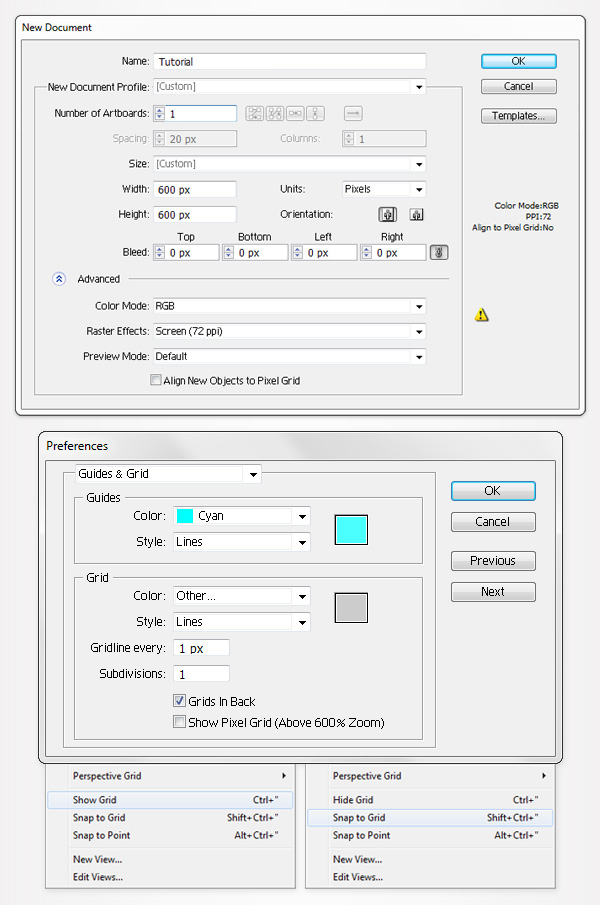
2. Create Your Flag Stand Base
Step 1
Using the Ellipse Tool (L), create a 36 by 10px shape and fill it with R=167, G=169, B=172. Switch to the Rectangle Tool (M), create a 36 by 5px shape, fill it with the same color and place it as shown in the second image. Open the Pathfinder panel (Window > Pathfinder), select the two shapes made in this step and click on the Unite button.
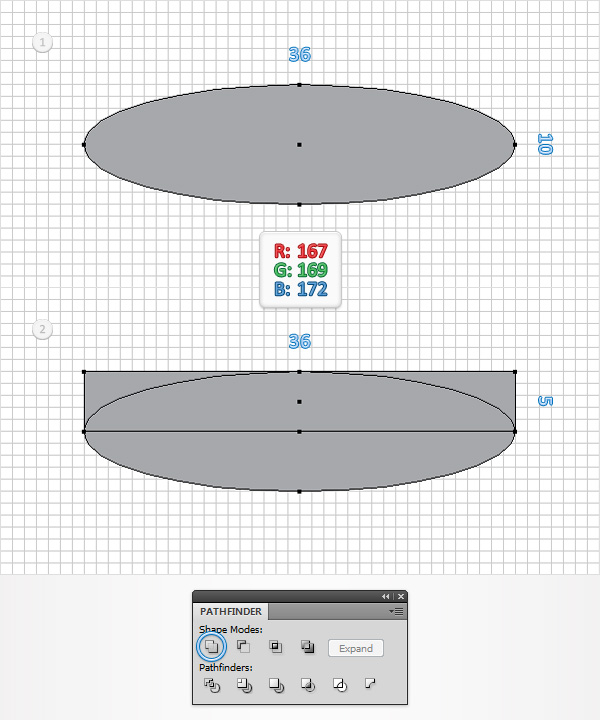
Step 2
Using the Ellipse Tool (L), create a 36 by 10px shape, fill it with white and place it as shown in the first image. Select this new shape along with the one made in the previous step and click on the Minus Front button from the Pathfinder panel. Fill the resulting shape with the linear gradient shown in the following image. The white numbers from the gradient image stand for Location percentage. Focus on the Gradient panel, click on that square gradient thumbnail and simply drag it inside the Swatches panel (Window > Swatches) to save this gradient. Keep focusing on the Swatches panel, double click on this newly added gradient and name it “Gradient1”.
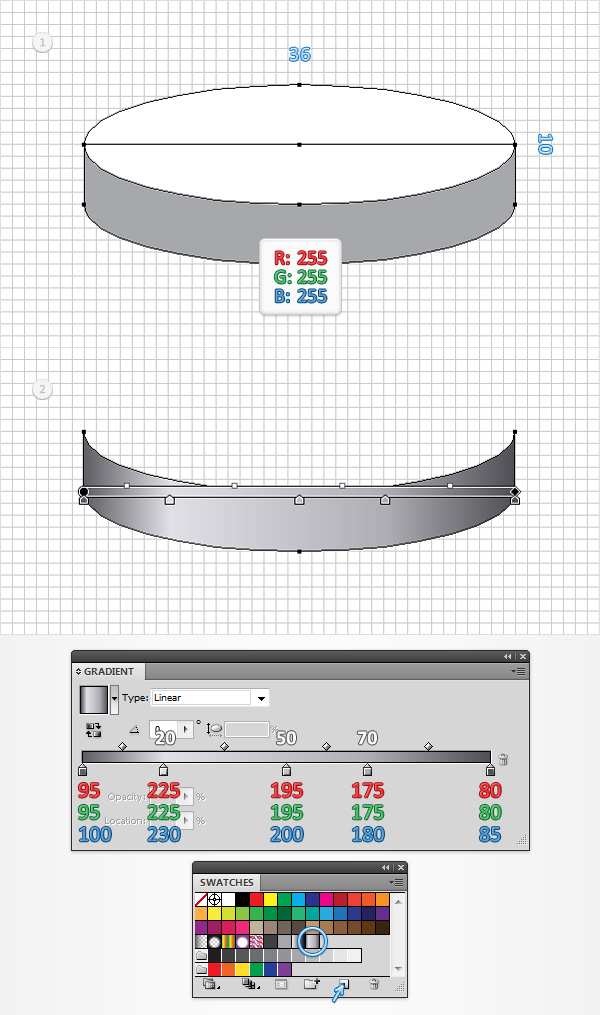
Step 3
Select the shape made in the previous step and make two copies in front (CTRL + C > CTRL + F > CTRL + F). Select the top copy and hit the up arrow once to move it 1px up. Reselect both copies and click on the Minus Front button from the Pathfinder panel. Fill the resulting shape with black, lower its Opacity to 30% and change the Blending Mode to Multiply.
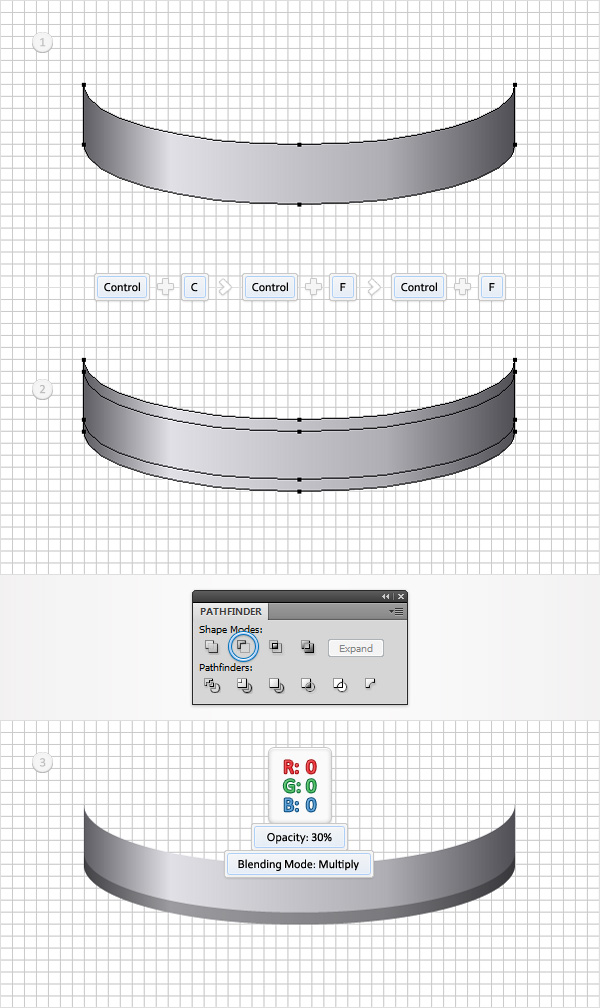
Step 4
Using the Ellipse Tool (L), create a 36 by 10px shape, fill it with the linear gradient shown below and place it as shown in the following image. Save this this new gradient and name it “Gradient2”. Make sure that the squeezed circle made in this step is still selected and make two copies in front (CTRL + C > CTRL + F > CTRL + F). Select the top copy and move it 1px up and to the right using the arrow keys from your keyboard. Reselect both copies and click on the Minus Front button from the Pathfinder panel. Fill the resulting shape with white and change its Blending Mode to Soft Light.

Step 5
Make sure that the squeezed circle made in the previous step is still selected and make two copies in front (CTRL + C > CTRL + F > CTRL + F). Select the top copy and move it 1px down and to the left using the arrow keys from your keyboard. Reselect both copies and click on the Minus Front button from the Pathfinder panel. Fill the resulting shape with black, lower its Opacity to 20% and change the Blending Mode to Overlay.
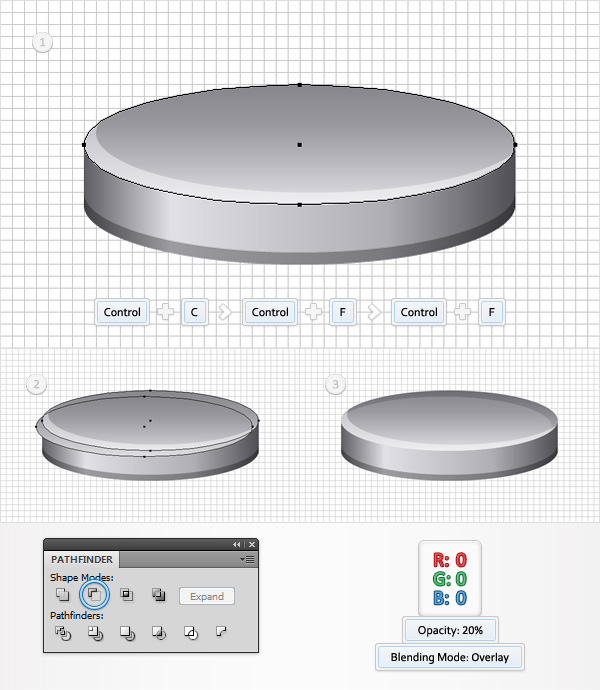
Step 6
Using the Ellipse Tool (L), create a 36 by 10px shape, fill it with black and place it as shown in the following image. Send this new shape to back (SHIFT + CTRL + [ ), make sure that it stays selected and focus on the Appearance panel. Select the existing fill, lower its Opacity to 15% and go to Effect > Path > Offset Path. Enter a 1px Offset and click OK. With this black fill still selected, focus on the bottom of the Appearance panel and click on the “Duplicate Selected Item button”. Obviously, this will duplicate the selected fill. Select this new fill and go to Effect > Blur > Gaussian Blur. Enter a 1px radius and click OK.
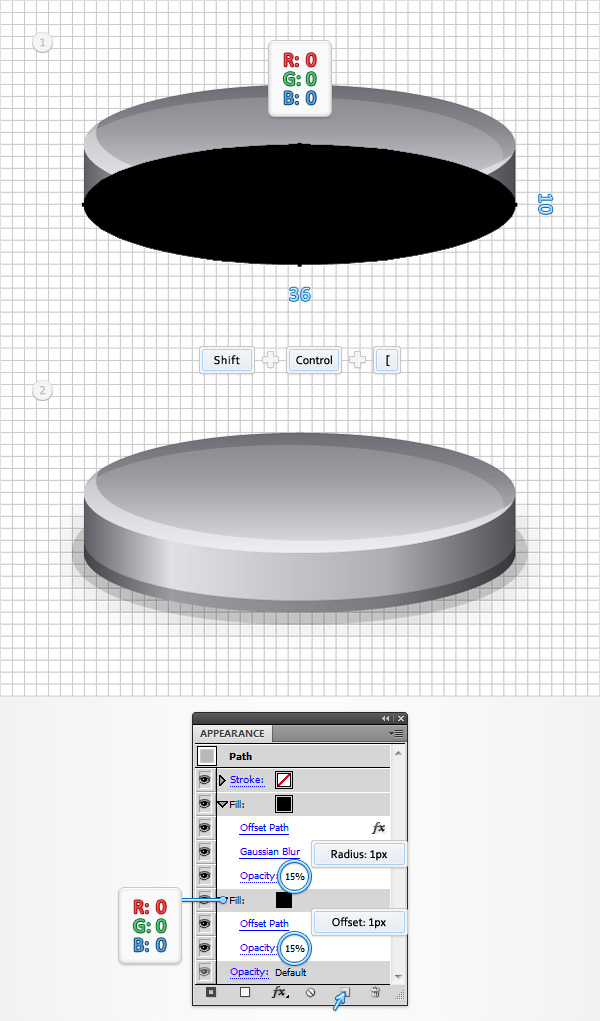
Step 7
Using the Ellipse Tool (L), create a 28 by 8px shape, fill it with R=167, G=169, B=172 and place it as shown in the first image. Switch to the Rectangle Tool (M), create a 28 by 4px shape, fill it with the same color and place it as shown in the second image. Select both shapes made in this step and click on the Unite button from the Pathfinder panel. Get back to the Ellipse Tool (L), create a 28 by 8px shape, fill it with white and place it as shown in the third image. Select this squeezed circle along with the other shape made in this step and click on the Minus Front button from the Pathfinder panel. Fill the resulting shape with “Gradient1”.
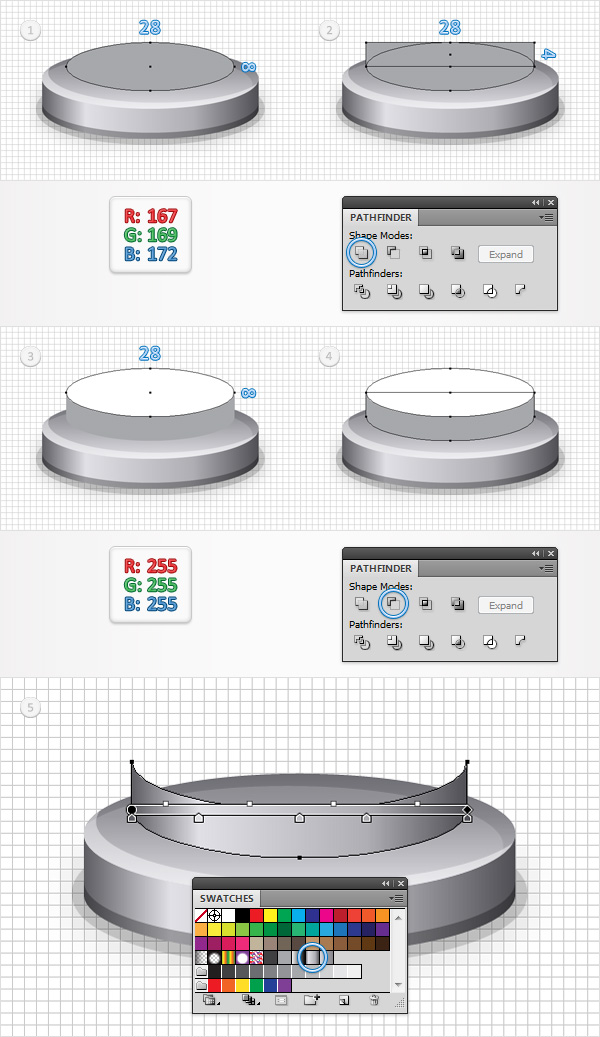
Step 8
Select the shape made in the previous step and make two copies in front (CTRL + C > CTRL + F > CTRL + F). Select the top copy and move it 1px up. Reselect both copies and click on the Minus Front button from the Pathfinder panel. Fill the resulting shape with black, lower its Opacity to 30% and change the Blending Mode to Multiply.
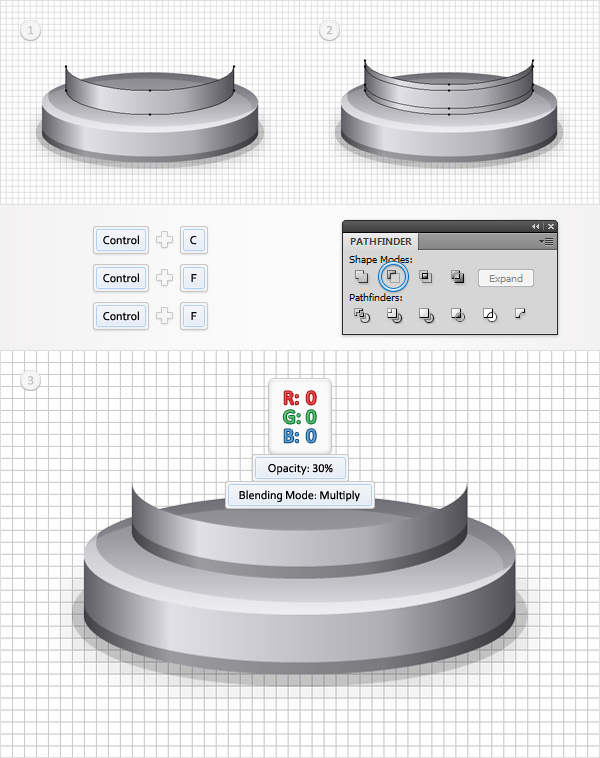
Step 9
Using the Ellipse Tool (L), create a 28 by 8px shape, fill it with “Gradient2” and place it as shown in the first image. Select this new shape and make two copies in front (CTRL + C > CTRL + F > CTRL + F). Select the top copy and move it 1px up and to the right using the arrow keys from your keyboard. Reselect both copies and click on the Minus Front button from the Pathfinder panel. Fill the resulting shape with white and change its Blending Mode to Soft Light.
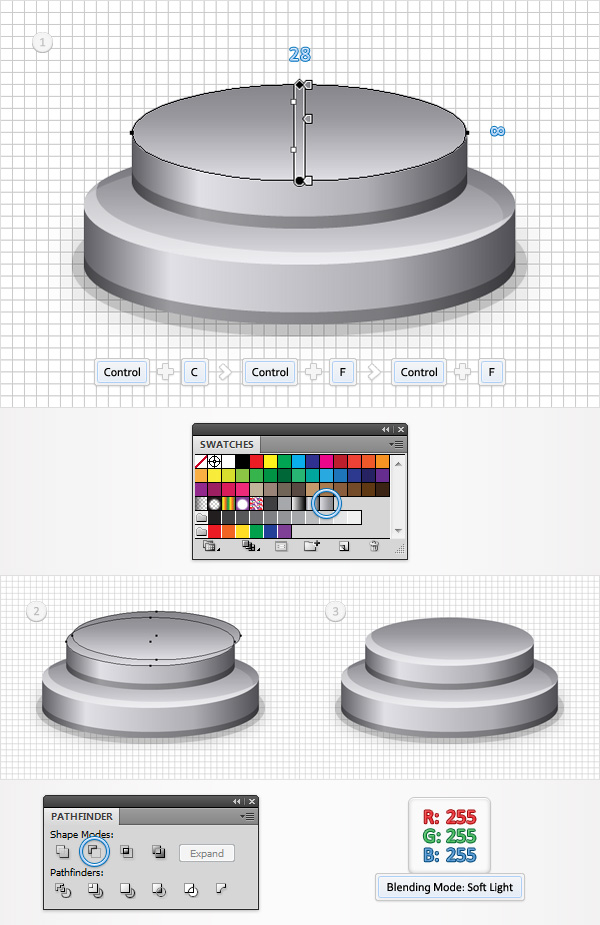
Step 10
Reselect the squeezed circle made in the previous step and make two copies in front (CTRL + C > CTRL + F > CTRL + F). Select the top copy and move it 1px down and to the left using the arrow keys from your keyboard. Reselect both copies and click on the Minus Front button from the Pathfinder panel. Fill the resulting shape with black, lower its Opacity to 20% and change the Blending Mode to Overlay.
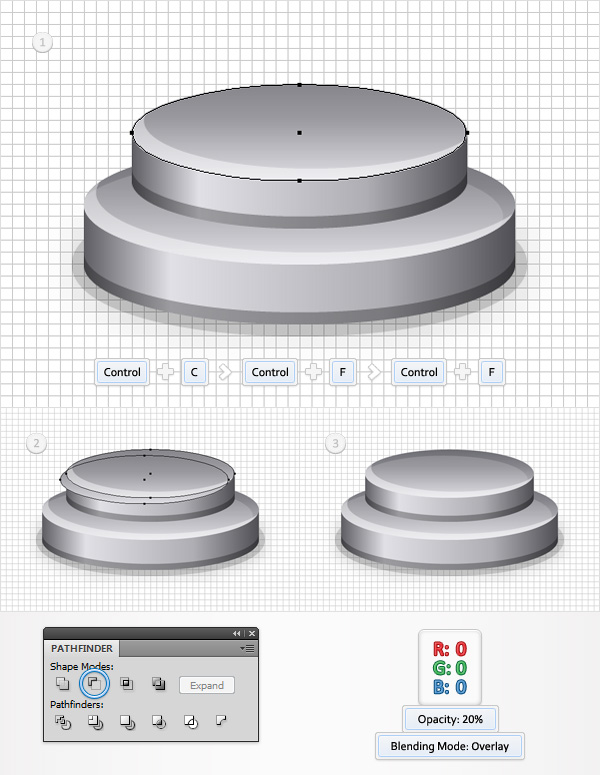
Step 11
Using the Ellipse Tool (L), create a 28 by 8px shape, fill it with black and place it as shown in the first image. Focus on the Layers panel and drag this squeezed circle below the shape made in Step 7. Make sure that this black shape is still selected and go to Effect > Stylize > Drop Shadow. Enter the properties shown in the following image and click OK. Select all the shapes created so far and Group them (CTRL + G).

3. Create Your Flag Pole
Step 1
Using the Rectangle Tool (M), create an 8 by 350px shape, fill it with the linear gradient shown below and place it as shown in the following image. Save this new gradient and name it “Gradient3”. Make sure this new shape stays selected and go to Effect > Stylize > Rounded Corners. Enter a 0.5px radius, click OK and go to Effect > Warp > Arc Lower. Enter the properties shown below, click OK and go to Effect > Stylize > Drop Shadow. Enter the properties shown in the following image and click OK.
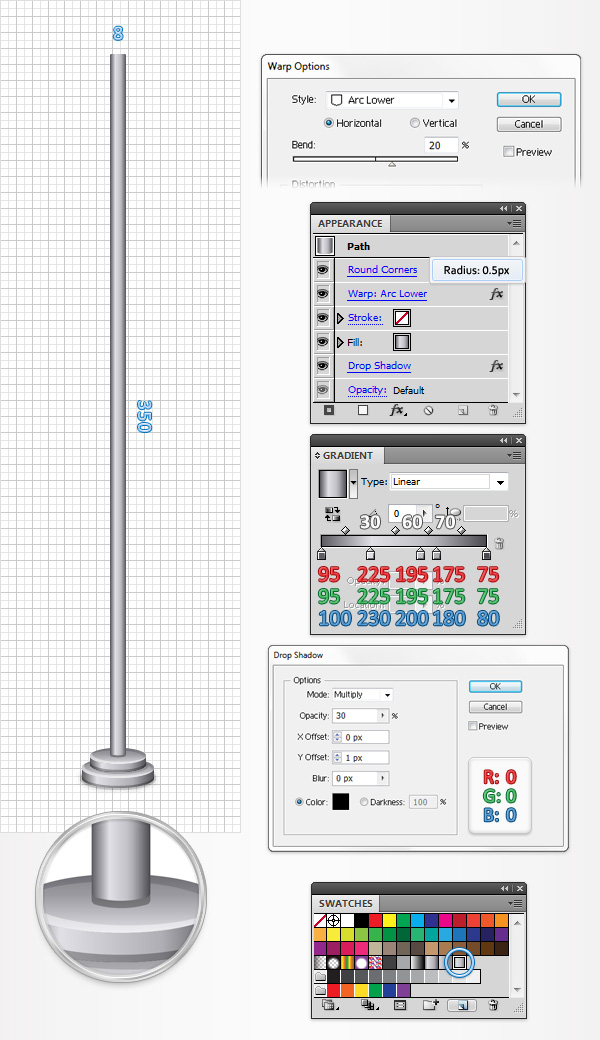
Step 2
Reselect the shape made in the previous step, focus on the Appearance panel and add a second fill using the Add New Fill button. Select it, lower the Opacity to 20% and use the linear gradient shown in the following image. Remember that the white number from the gradient image stands for Location percentage while the yellow zero stands for Opacity percentage.
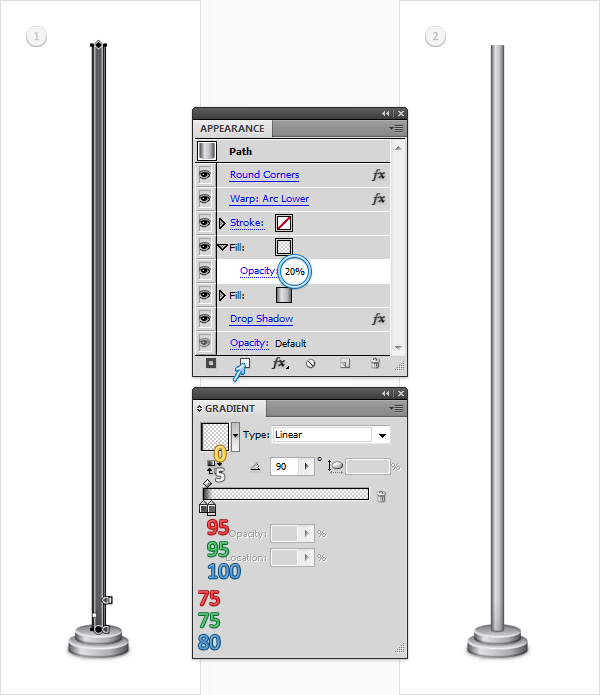
4. Create the Top Elements of the Pole
Step 1
Focus on the top side of the vector shape edited in the previous step. Using the Ellipse Tool (L), create a 10 by 2px shape, fill it with R=167, G=169, B=172 and place it as shown in the first image. Switch to the Rectangle Tool (M), create a 10 by 3px shape, fill it with the same color and place it as shown in the second image. Select both shapes made in this step and click on the Unite button from the Pathfinder panel. Reselect the Ellipse Tool (L), create a 10 by 2px shape, fill it with white and place it as shown in the third image. Select this squeezed circle along with the other shape made in this step and click on the Minus Front button from the Pathfinder panel. Fill the resulting shape with “Gradient3”.

Step 2
Select the shape made in the previous step and make two copies in front (CTRL + C > CTRL + F > CTRL + F). Select the top copy and move it 1px down. Reselect both copies and click on the Minus Front button from the Pathfinder panel. Fill the resulting shape with white and change its Blending Mode to Soft Light.
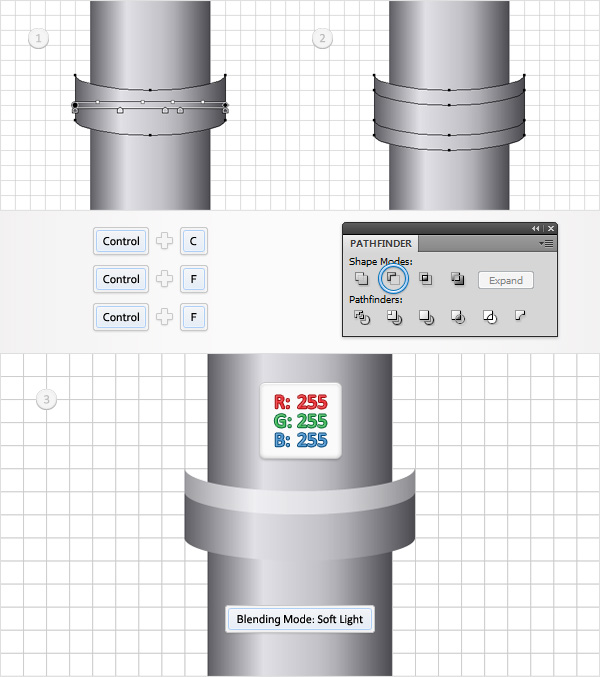
Step 3
Reselect the long shape and make a copy in front (CTRL + C > CTRL + F) then select the shape made in the fifteenth step and make a copy in back (CTRL + C > CTRL + B). Select this second copy and move it 1px down. Reselect both copies made in this step and click on the Intersect button from the Pathfinder panel. Fill the resulting shape with black and lower its Opacity to 20%.
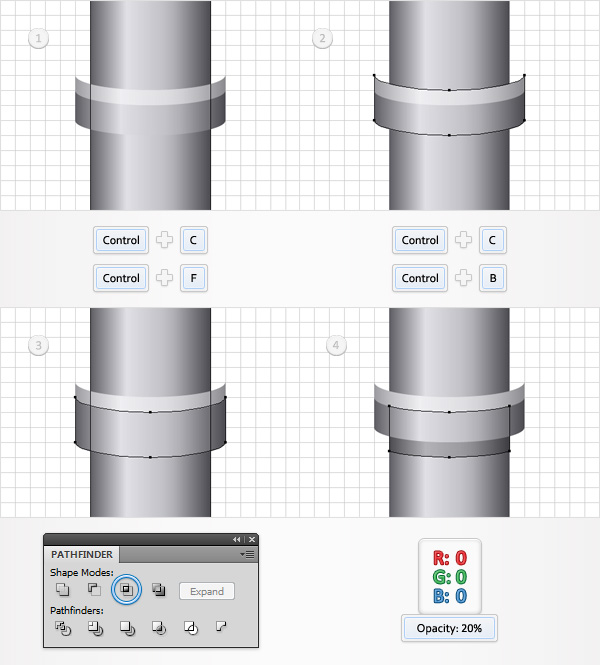
Step 4
Using the Ellipse Tool (L), create a 10 by 2px shape, fill it with white and place it as shown in the first image. Select this squeezed circle and make two copies in front (CTRL + C > CTRL + F > CTRL + F). Select the top copy and move it 1px up. Reselect both copies and click on the Intersect button from the Pathfinder panel. Fill the resulting shape with R=237, G=28, B=36. Reselect the white shape made in the beginning of the step and make a new copy in front (CTRL + C > CTRL + F). Select it and move it 1px up. Reselect both white shapes and click on the Minus Front button from the Pathfinder panel.
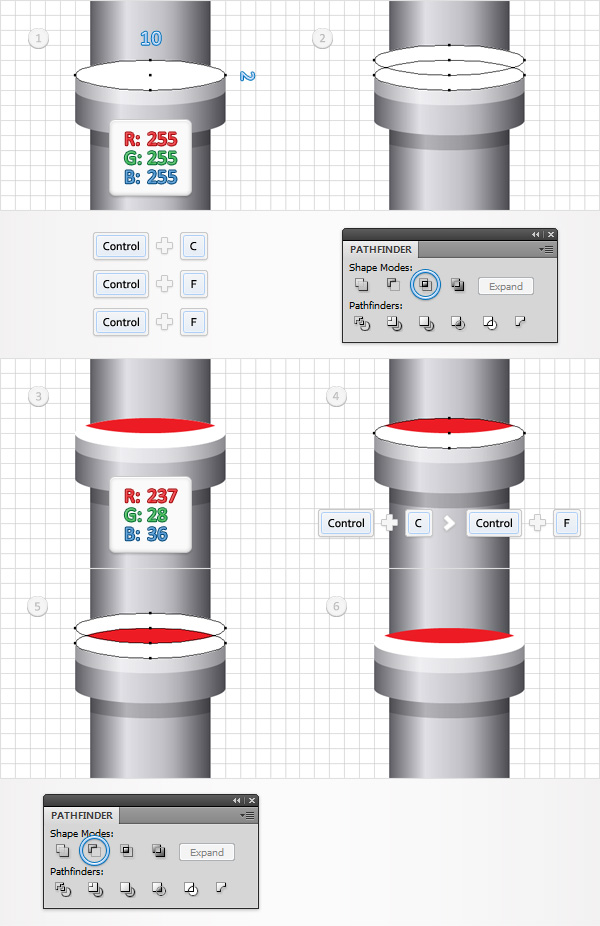
Step 5
Reselect that long shape, make a copy in front (CTRL + C > CTRL + F) and Bring it to Front (SHIFT + CTRL + ] ). Select this copy along with the red shape made in the previous step, click on the Minus Front button from the Pathfinder panel and you will get a group with two tiny, red shapes. Select it along with the white shape made in the previous step and click on the Unite button from the Pathfinder panel. Fill the resulting shape with the linear gradient shown in the final image.
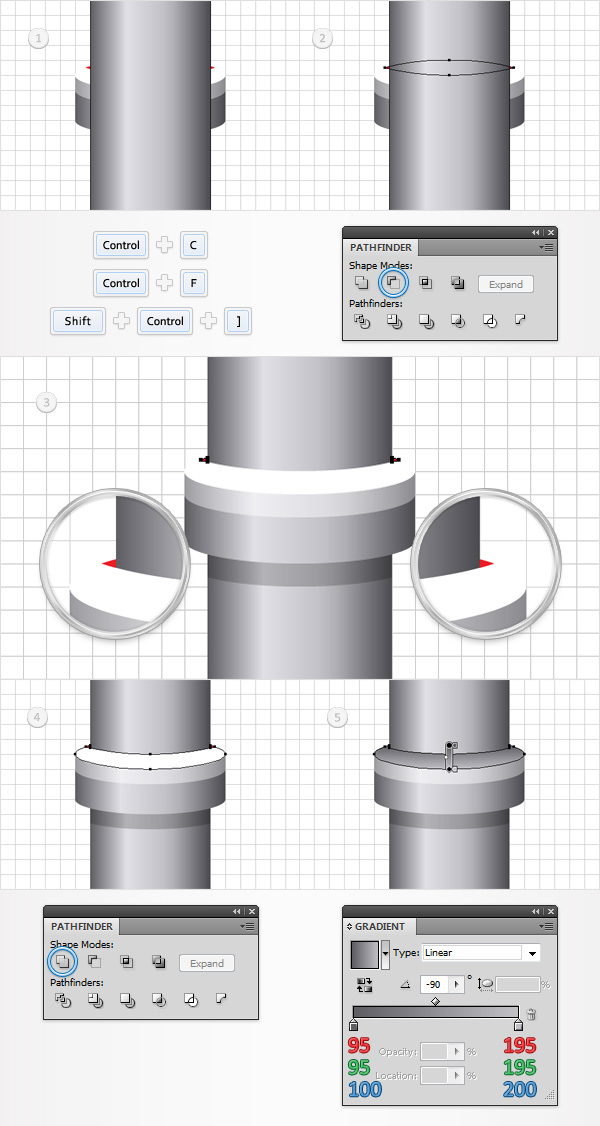
Step 6
Select the four shapes made in the last five steps and Group them (CTRL + G). Make a copy of this group (CTRL + C > CTRL + F), select it and simply drag it 10px down as shown in the second image.
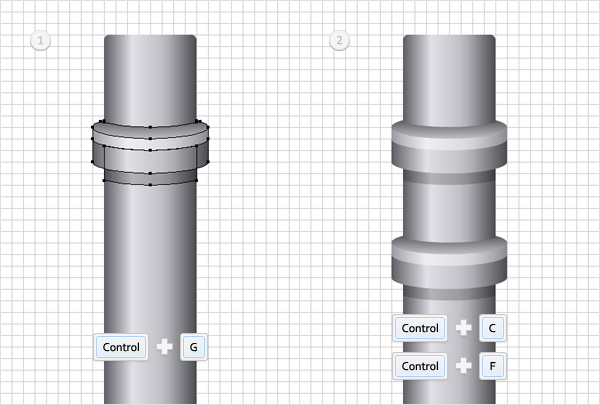
Step 7
Using the Ellipse Tool (L), create a 14px circle, fill it with the radial gradient shown below and place it as shown in the first image. Reselect the long shape and make a copy in front (CTRL + C > CTRL + F) then select the circle made in the beginning of the step and make a copy in back (CTRL + C > CTRL + B). Select this second copy and move it 1px down. Reselect both copies and click on the Intersect button from the Pathfinder panel. Fill the resulting shape with black and lower its Opacity to 20%. Using the Ellipse Tool (L), create a 5px circle and place it as shown in the final image. Fill it with white, lower its Opacity to 75% and change the Blending Mode to Soft Light

Step 8
Select all the shapes created so far and Group them (CTRL + G). Move to the Layers panel, double click on this new group and simply name it “pole”.

5. Create Your Flag Base
Step 1
Next, you need to create a simple pattern. Using the Rectangle Tool (M), create a 1px square and fill it with black. Select this tiny shape and go to Effect > Distort & Transform > Transform. Enter the properties shown in the following image and click OK. In the end things should look like in the second image. Now, make sure that this tiny square is still selected, simply drag it inside your Swatches panel and you got you pattern. Return to the Layers panel and remove your black square.
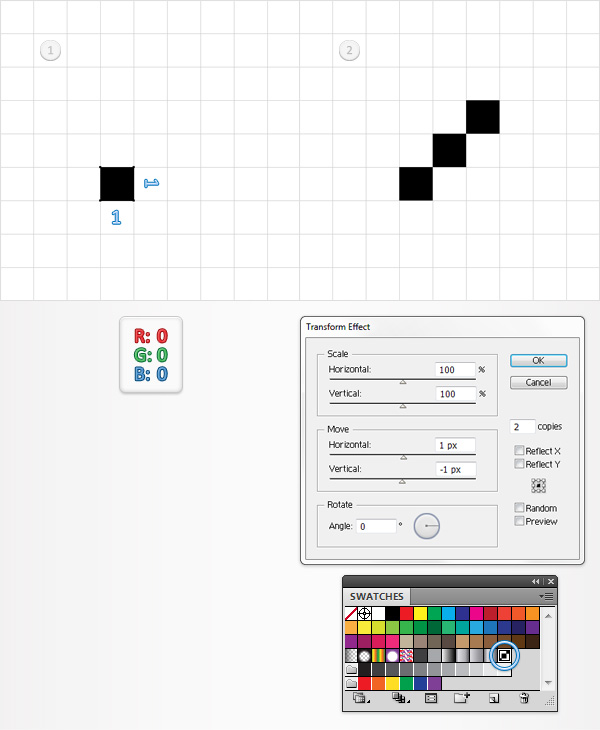
Step 2
Using the Rectangle Tool (M), create a 110 by 176px shape, fill it with R=235, G=235, B=230 and place it as shown in the first image. Next, you need to align this new rectangle. Select it along with the “pole” group, make sure that the Selection Tool (V) is active and open the Align panel (Window > Align). Now, click on the border of your “pole” (it should get emphasized) then click on the “Horizontal Align Center” and “Vertical Align Center” buttons from the Align panel. Finally, make sure that there’s a 33px gap between this new rectangle and the bottom notch as shown in the last image. Use the grid as a reference.

Step 3
Reselect the shape made in the previous step and add a second fill using the Add New fill button. Select this new fill, lower its Opacity to 10% and use the pattern.
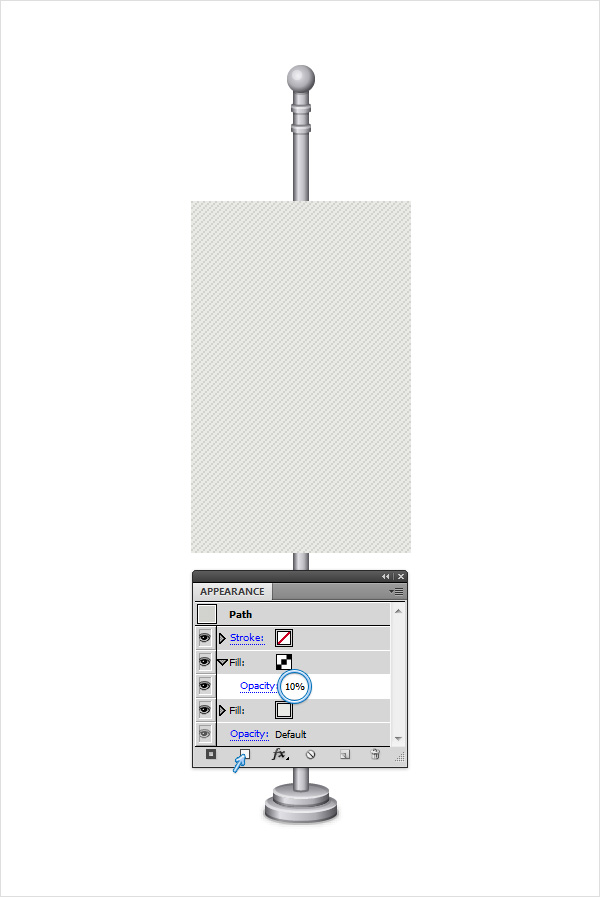
Step 4
Focus on the top side of your patterned shape. Using the Rectangle Tool (M), create a 110 by 4px shape, fill it with the linear gradient shown below and place it as shown in the first image. Don’t forget that the white number from the gradient image stands for Location percentage while the yellow numbers stand for Opacity percentage. Select this new rectangle and make two copies in front (CTRL + C > CTRL + F > CTRL + F). Focus on the Layers panel, select the bottom copy and move it 1px down. Reselect both copies and click on the Minus Front button form the Pathfinder panel. Fill the resulting shape with white and lower its Opacity to 60%.

Step 5
Focus on the bottom side of your patterned shape. Using the Rectangle Tool (M), create a 110 by 4px shape, fill it with the linear gradient shown below and place it as shown in the first image. Select this new rectangle and make two copies in front (CTRL + C > CTRL + F > CTRL + F). Focus on the Layers panel, select the bottom copy and move it 1px up. Reselect both copies and click on the Minus Front button form the Pathfinder panel. Fill the resulting shape with black and lower its Opacity to 10%.
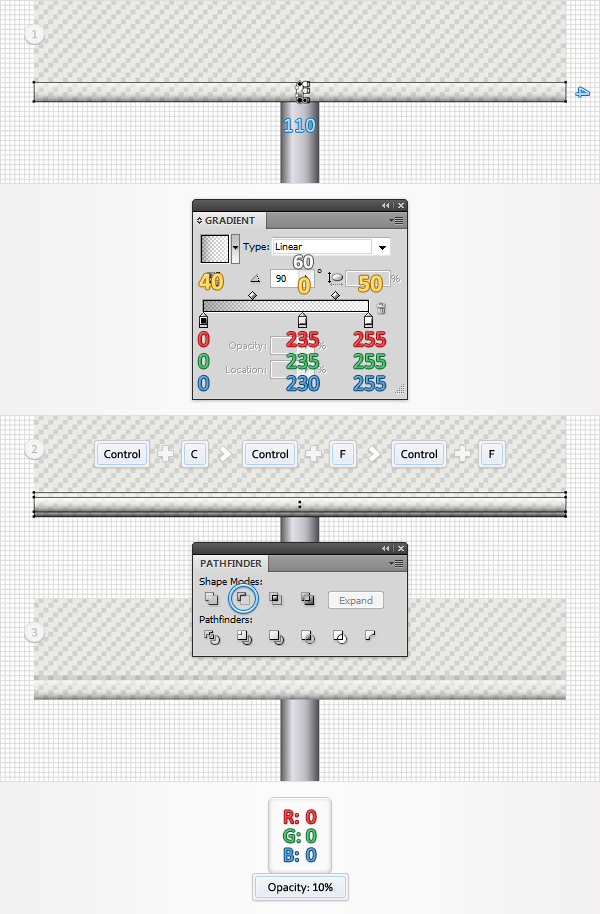
Step 6
Get back to the top of your patterned shape, grab the Rectangle Tool (M) and create a 3 by 1px shape. Fill it with R=187, G=187, B=183, place it as shown in the first image and go to Effect > Stylize > Rounded Corners. Enter a 0.5px radius, click OK and go to Effect > Stylize > Drop Shadow. Enter the properties shown in the following image and click OK. Make sure that this tiny rectangle is still selected and make a copy in front (CTRL + C > CTRL + F). Select it, drag it in the bottom of your patterned shape and place it as shown in the second image.

Step 7
Reselect both shapes made in the previous step and go to Effect > Distort & Transform > Transform. Enter the properties shown in the following image and click OK.
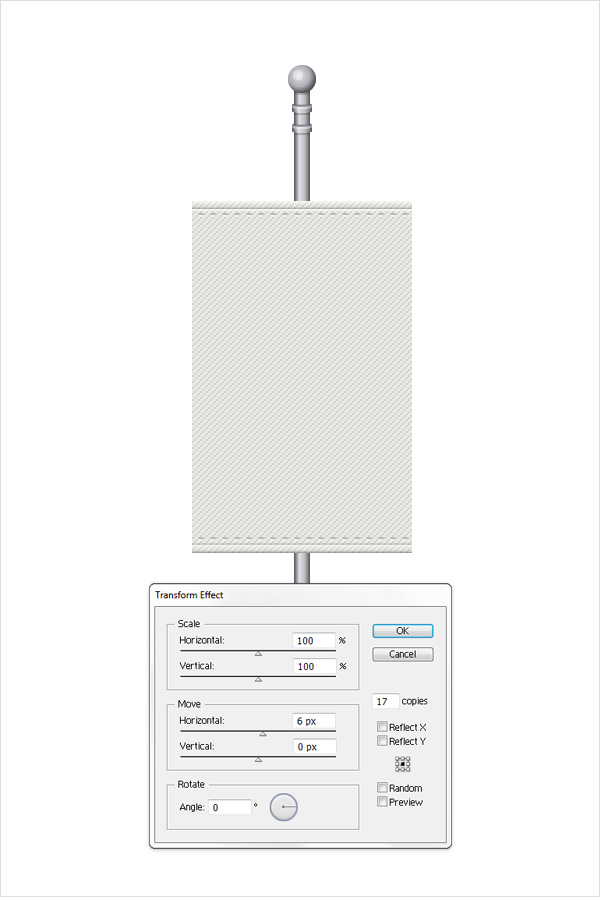
6. Add Tassels to Your Flag
Step 1
Focus on the bottom, left corner of your patterned shape. Using the Rectangle Tool (M), create two, 1 by 7px shapes, fill them with the linear gradient shown below and place them as shown in the following image.
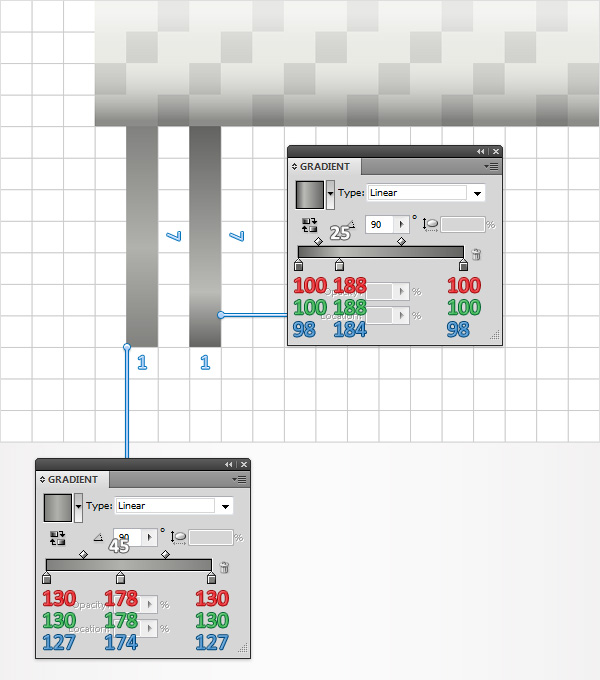
Step 2
Reselect both rectangles made in the previous step and go to Effect > Distort & Transform > Transform. Enter the properties shown in the following image and click OK.
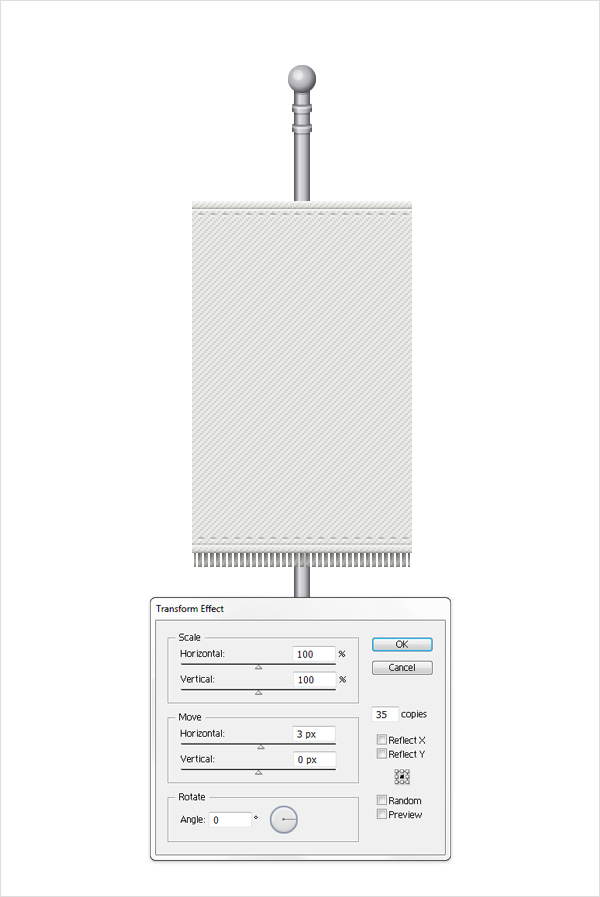
7. Refine the Shadow on the Pole
Step 1
Using the Rectangle Tool (M), create an 8 by 1px shape and an 8px square. Fill both shapes with black, lower their Opacity to 20% and place them as show in the following image. Focus on the Layers panel, select that 8px square and drag it below the two rectangles edited in the previous step.
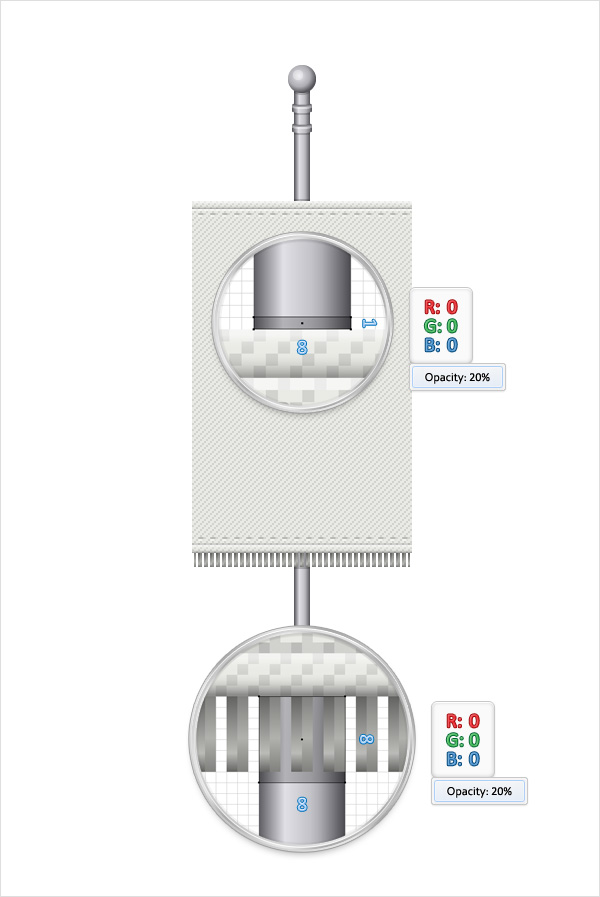
Step 2
Select all the shapes created so far and Group them (CTRL + G). Move to the Layers panel and name this new group “flag”.
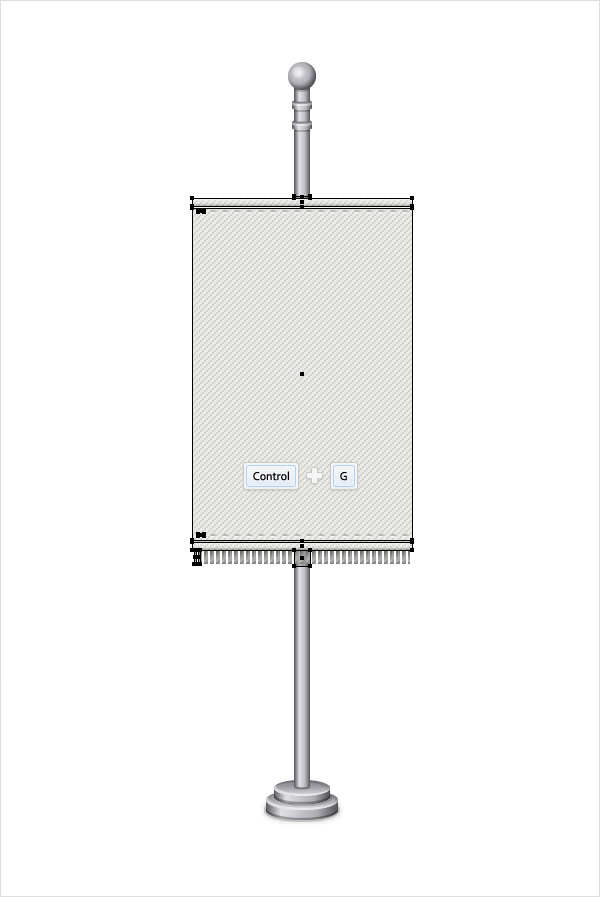
8. Add the Rope to Hang the Flag
Step 1
Using the Rectangle Tool (M), create a 112 by 42px shape and place it as shown in the first image. Fill it with none, but add a 2pt Stroke Weight. Select it, set the color at R=169, G=124, B=80 and open the Stroke panel (Window > Stroke). Check the “Round Cap” and “Round Join” buttons then go to Object > Path > Add Anchor Points.
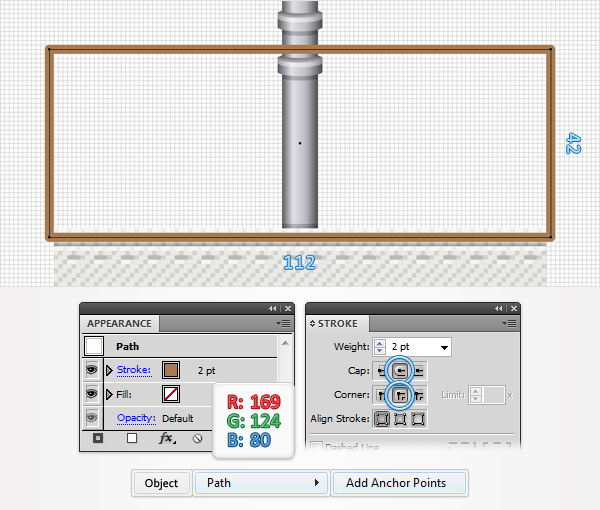
Step 2
Make sure that the shape made in the previous step stays selected and grab the Direct Selection Tool (A). First, select the two anchor points highlighted in the first image and drag them 17px down. Next, select the top, left anchor point and drag it 52px to the right then select the top, right anchor point and move it 52px to the left. Finally, go to Effect > Stylize > Rounded Corners. Enter a 3px radius, click OK and go to Object > Path > Outline Stroke.
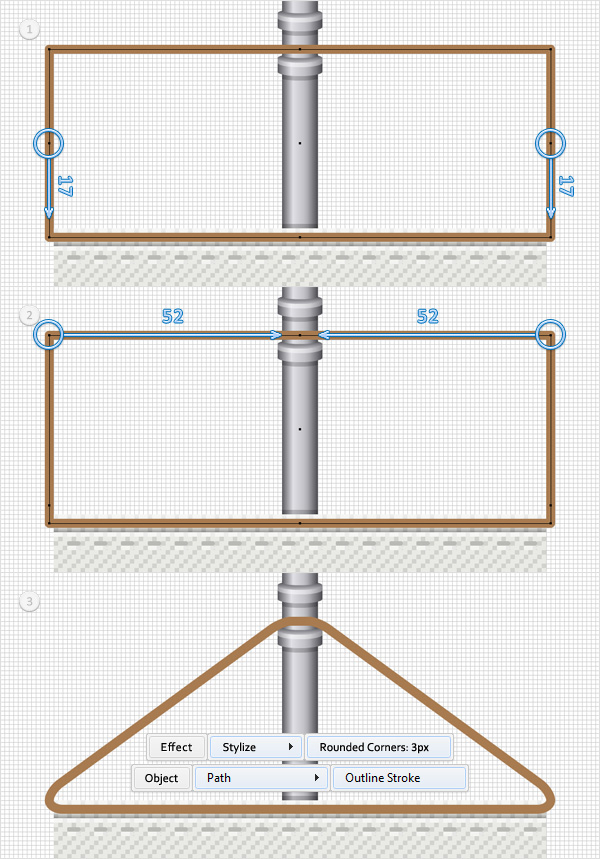
Step 3
Disable the Snap to Grid (View > Snap to Grid) then go to Edit > Preferences > General and make sure that the Keyboard Increment is set at 1px. Select the shape made in the previous step and make two copies in front (CTRL + C > CTRL + F > CTRL + F). Select the top copy and move it 1px down. Reselect both copies and click on the Minus Front button from the Pathfinder panel. Turn the resulting group of shapes into a Compound Path (Object > Compound Path > Make or CTRL + 8) and set its fill color at R=215, G=185, B=155.
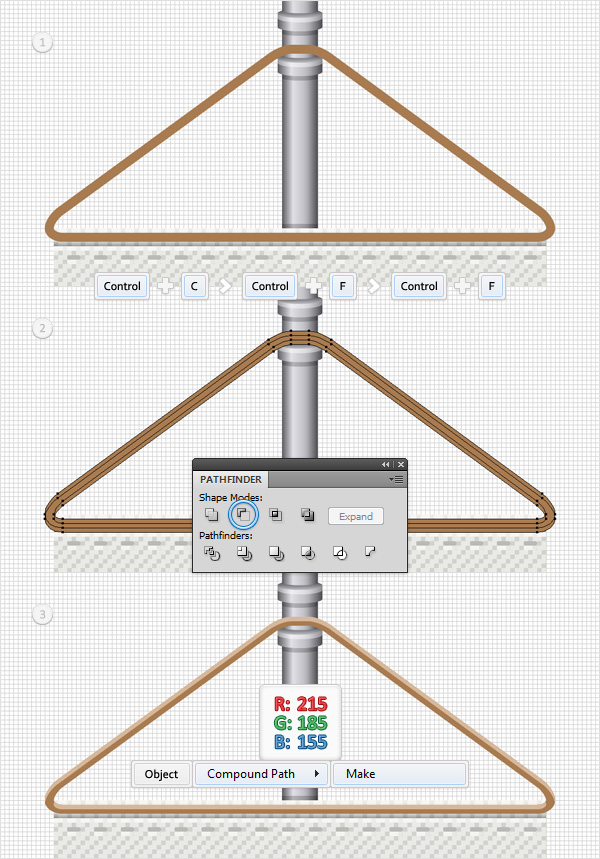
Step 4
Select the shape made for the rope and make two copies in front (CTRL + C > CTRL + F > CTRL + F). Select the top copy and move it 1px up. Reselect both copies and click on the Minus Front button from the Pathfinder panel. Turn the resulting group of shapes into a Compound Path (CTRL + 8) and set its fill color at R=111, G=59, B=25.

Step 5
Select the shape made for the rope and make a copy in front (CTRL + C > CTRL + F). Select it, bring it to front (SHIFT + CTRL + ] ) and replace the flat color used for the fill with the radial gradient shown in the second image.
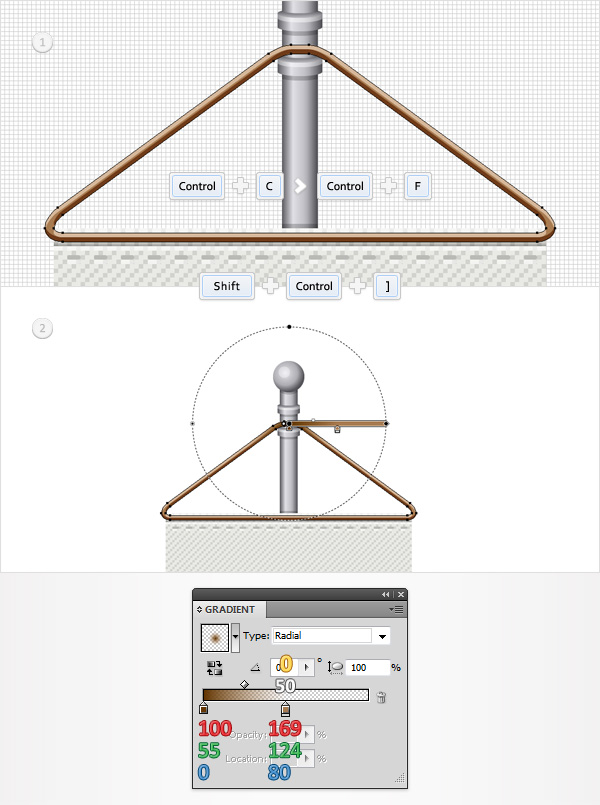
Step 6
Select all the shapes made in the last five steps and Group them (CTRL + G). Move to the Layers panel, name this new group “thread” then send it to back (SHIFT + CTRL + [ ).

Step 7
Enable the Snap to Grid (View > Snap to Grid). Using the Ellipse Tool (L), create an 8 by 2px shape and place it as shown in the first image. Fill it with none, but add a 2pt Stroke Weight with the color set at R=169, G=124, B=80. Focus on this squeezed circle, switch to the Direct Selection Tool (A), select the top anchor point and simply hit the Delete key from your keyboard. Focus on the resulting shape, make sure that the stroke is selected, check Round Cap button from the Stroke panel then go to Object > Path > Outline Stroke. Select the resulting shape and replace the flat color used for the fill with the linear gradient shown in the third image.

Step 8
Select the shape made in the previous step and make two copies in front (CTRL + C > CTRL + F > CTRL + F). Select the top copy and move it 1px up. Reselect both copies and click on the Minus Front button from the Pathfinder panel. Fill the resulting shape with black, lower its Opacity to 50% and change the Blending Mode to Soft Light. Select this black shape along with the shape made in the previous step and Group them (CTRL + G). Make a copy of this group (CTRL + C > CTRL + F), select it and place it as shown in the fifth image.

9. Create A Pen Tool Icon
Step 1
For the following step you will need a grid every 5px. So, go to Edit > Preferences > Guides & Grid and enter 5 in the Gridline every box. Using the Rectangle Tool (M), create a 20 by 15px shape, fill it with none, but add a 5pt Stroke Weight. Align it to inside and set the color at R=187, G=187, B=183. Continue with the Rectangle Tool (M), create a 30 by 5px shape, fill it with R=187, G=187, B=183 and place it as shown in the second image. Using the Rectangle Tool (M), create a 20 by 60xp shape and place it as shown in the third image. Fill it with none, but add a 5pt Stroke Weight, set the color at R=187, G=187, B=183 and align it to inside. Make sure that this third rectangle is still selected and go to Object > Path > Add Anchor Points. Switch to the Direct Selection Tool (A), select the left anchor point highlighted in the third image and drag it 10px down and to the left then select the right anchor point highlighted in the third image and drag it 10px down and to the right. In the end your shape should look like in the fourth image.
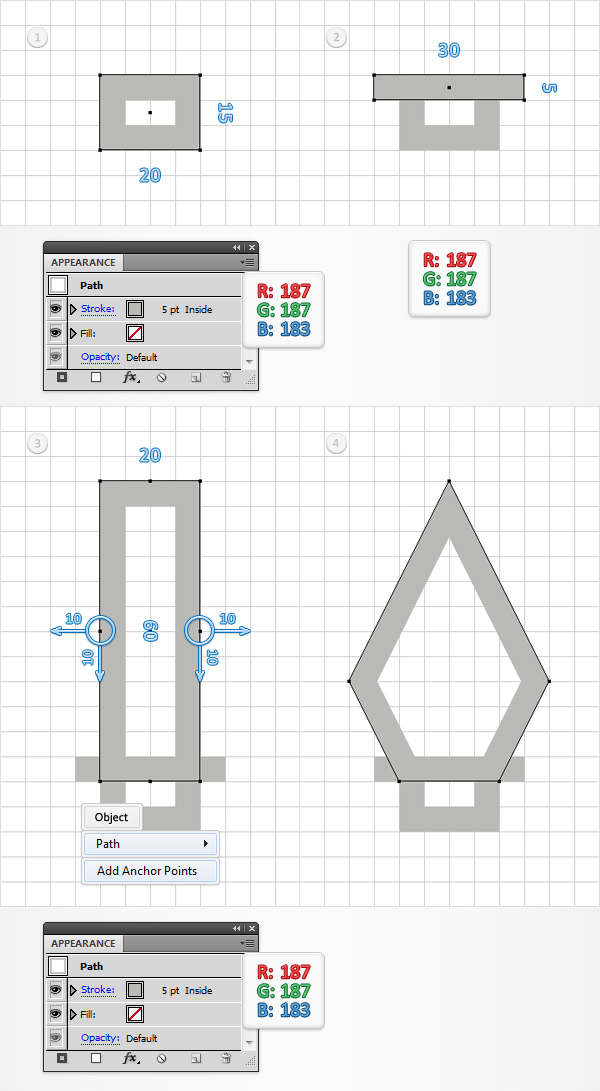
Step 2
Make sure that the third shape made in the previous step is still selected and grab the Convert Anchor Point Tool (SHIFT + C). Click on the top anchor point and simply drag 10px to the left. The Snap to Grid will ease tour work. Now things should look like in the first image. Switch to the Direct Selection Tool (A), hold the ALT key from your keyboard then click on the right handle and drag it 15px down and 5px to the left. Move to the left handle and drag it 15px down and 5px to the right. In the end things should look like in the third image.

Step 3
Pick the Pen Tool (P), draw a 30px, vertical path and place it as shown in the first image. Add a 5px Stroke Weight for this path, set its color at R=187, G=187, B=183 and check the Round Join button from the Stroke panel. Return to “gridline every 1px”. Simply go to Edit > Preferences > Guides & Grid and enter 1 in the Gridline every box. Using the Ellipse Tool (L), create an 8px circle, fill it with R=187, G=187, B=183 and place it as shown in the second image.
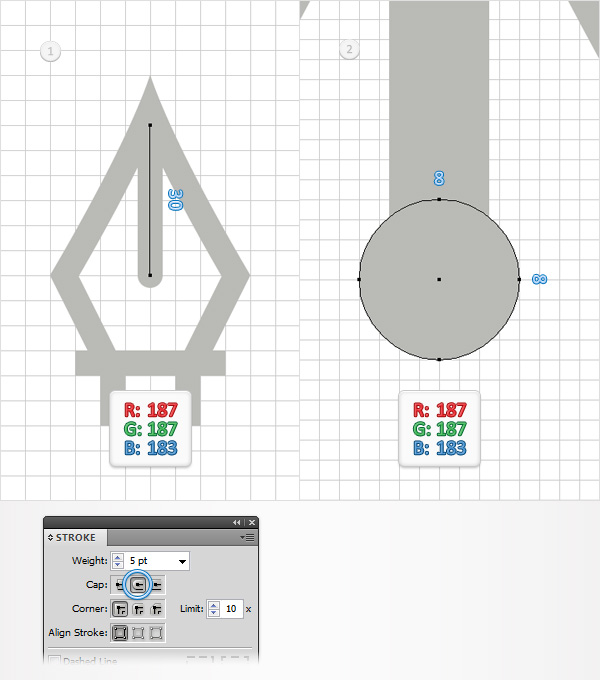
Step 4
Select all the shapes made in the last three steps and go to Object > Path > Outline Stroke. Select the resulting shapes and click on the Unite button from the Pathfinder panel.
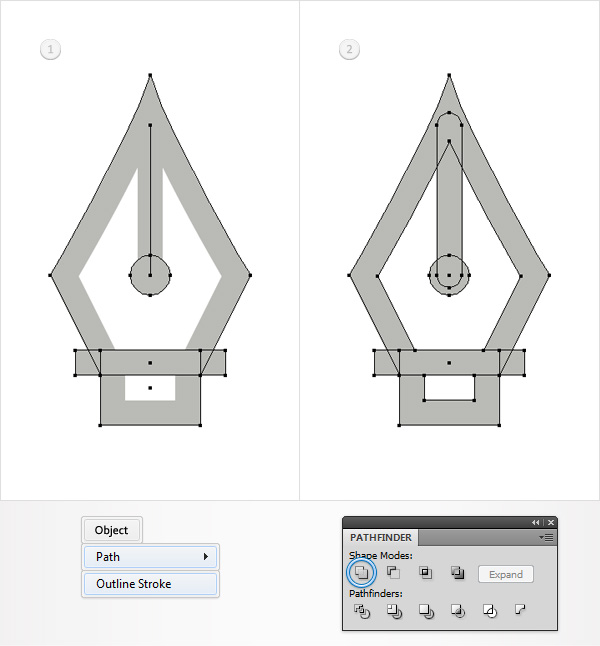
Step 5
Select the shape made in the previous step along with the patterned rectangle from the “flag” group align to center your Pen Tool shape.
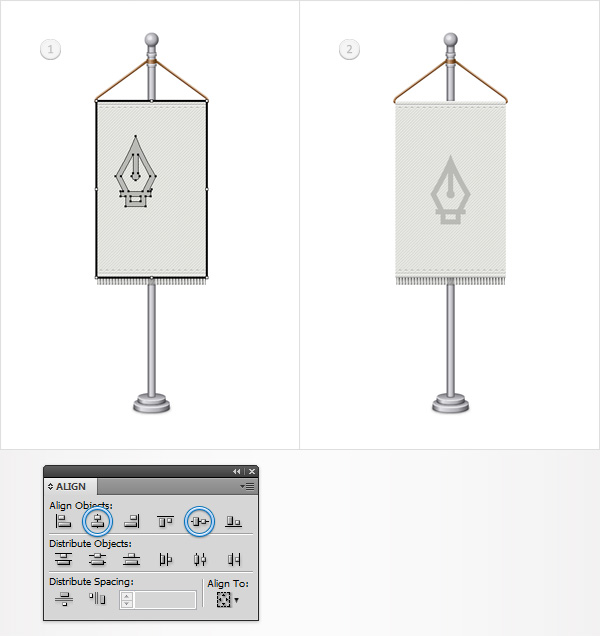
Step 6
Select your Pen Tool shape and open the Transform panel (Window > Transform). Check the “Constrain” button and simply enter 45 in the weight box. Make sure that the Pen Tool shape is still selected and go to Effect > Stylize > Drop Shadow. Enter the properties shown in the following image and click OK.

10. Create a Golden Version of Your Flag
If you prefer the golden version here are the colors and the linear gradient that you will need. First, focus on the bottom group of shapes. Replace “Gradient1” with the left linear gradient shown below and “Gradient2” with the right linear gradient shown in the following image.
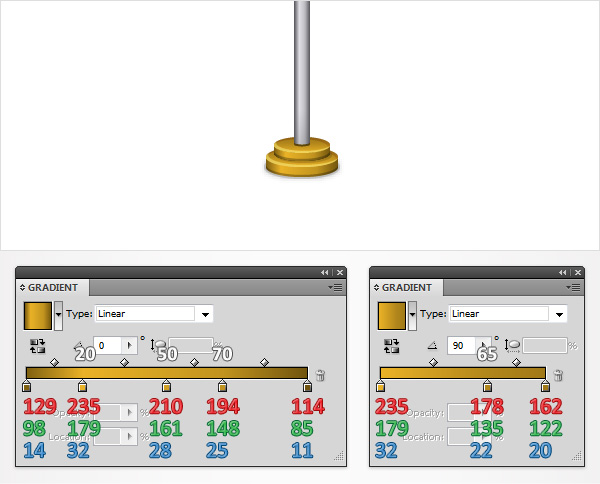
Keep focusing on the pole and replace “Gradient3″ with the left linear gradient shown below. Focus on the top shapes that make up those little notches and replace the existing linear gradient with the one shown in the following image.

Continue with that 14px circle and replace the existing radial gradient with the one shown in the following image.
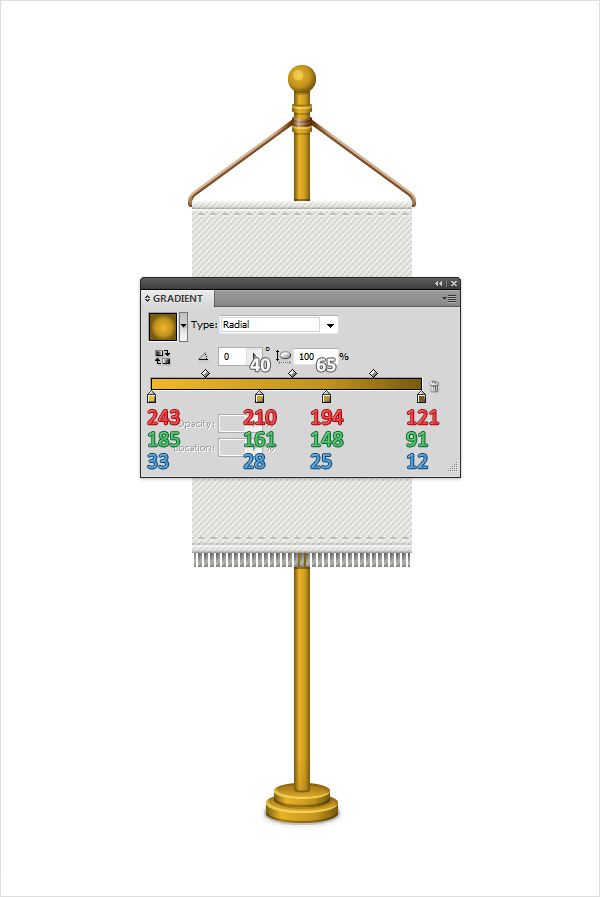
Finally, here are the colors and the gradients that you will need for the flag.
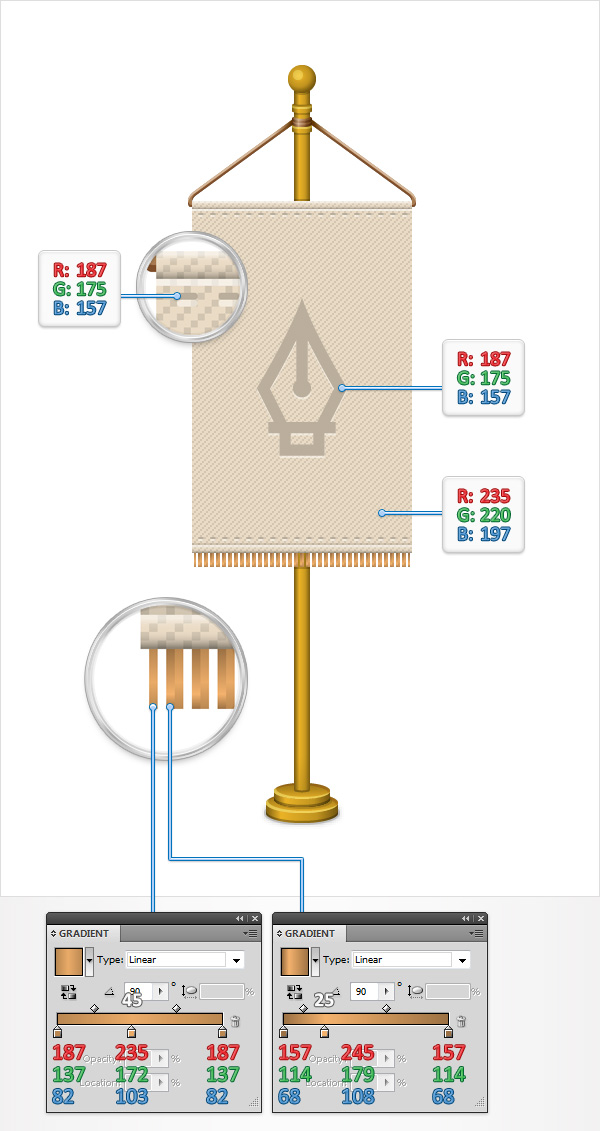
Awesome Job, You’re Now Done!
Now your work is done. Here is how it should look. Feel free to try a different set of color for the overall illustration or to replace the Pen Tool logo with your own logo. I hope you’ve enjoyed this tutorial and can apply these techniques in your future projects.